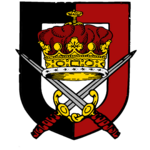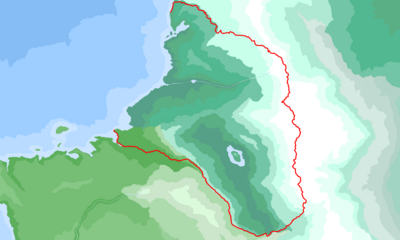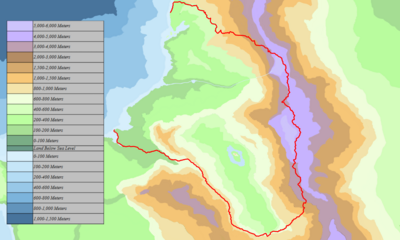Khijovia
This article is incomplete because it is pending further input from participants, or it is a work-in-progress by one author. Please comment on this article's talk page to share your input, comments and questions. Note: To contribute to this article, you may need to seek help from the author(s) of this page. |
Ascended Kingdom of Khijovia Khıjovïænne Æšcaēe Raēgə | |
|---|---|
Motto: "Seþþə vīəra Raehxxa nīəva Matrïænne jmørrə" "Love of the Motherland is our only Law" | |
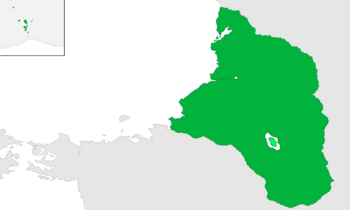 Lands and surroundings of the Ascended Kingdom of Khijovia, 1613 AR | |
| Capital | Kleitore |
| Largest | Xoviah |
| Official languages | Khijovian |
| Recognised regional languages | Teutorian, Aldorian, Koritian |
| Ethnic groups | Humans (100%) |
| Religion | Aravianism |
| Demonym(s) | Khijovian |
| Government | Feudalistic Constitutional Monarchy |
• Ascended King of Khijovia | Arcadion II |
• Ascended Queen of Khijovia | Carevia I |
| Legislature | Royal Parliament |
| Establishment | |
• Foundation of the Ascended Kingdom | July 3, 1607 AR |
| Area | |
• Land Area | 1,386,546 km2 (535,348 sq mi) |
• Water (%) | 3,8 |
| Population | |
• 1613 AR estimate | 51,085,900 |
| GDP (nominal) | estimate |
• Total | $ 225,000,000,000.00 |
• Per capita | $ 4,405.00 |
| Currency | Shonnenor (SHN) |
| Date format | dd/mm/yy |
| Driving side | right |
Khijovia (Khijovian: Khıjovïæ [kɪjəʊviə]), officially the Ascended Kingdom of Khijovia, is a feudalistic constitutional monarchy situated in northwestern Pelia, with Kleitore serving as its capital. It shares its borders with the Federated People's Republic of Kyldigard to the north and the Kingdom of Prestore to the south, while the Kesper Sea lies to the west. With a population of approximately 51 million inhabitants, Khijovia occupies the northern part of the High West region and holds the Recondian Archipelago in the Wintry Ocean. Established in 1607 AR by Arcadion II following the collapse of the Khijovian Federation and the return of the Zenonian Dynasty, the Ascended Kingdom is divided into 27 fiefdoms and a special administrative district. Known for its deeply spiritual society, Khijovia has maintained a unique connection with the magical arts throughout its history.
Etymology
The origin of the name Khijovia has long intrigued linguists and historians, prompting diverse reconstructions. While some theories delve into etymological roots, others are steeped in historical narratives, including the intriguing notion of an ancient pre-Shuffle king named Khjvonnə in popular traditions.
One prevalent theory suggests that the name stems from Khyjvīə, an exoethnonym used by the Koritians for a tribe residing in the neighboring Aldoria region. Another hypothesis, not mutually exclusive, proposes that these people venerated a pagan deity, Khœvă, making the name signify "inhabitants of the land of Khœvă."
Alternatively, a distinct theory posits a simpler origin—the semantic fusion of Khvıəyūtœnnə, an adjective linked to the Kveutonian Empire, and Jyovïæhnnə, associated with the Jovianic Order and its doctrine.
History
During ancient times, Khijovia served as a crossroads for numerous neolithic cultures. Thriving city-states emerged during the Era of Ruin, preserving their cultural identity and language staunchly against external influences. Notwithstanding the upheavals in the rest of Sparkalia, Khijovia remained isolated, relatively unaffected by wars and famines until the catastrophic Abheric Wars and the subsequent collapse of the city-state system around 277 BR, ushering in the Barren Age and marking the end of the Archaic Age in Khijovian history. Despite suffering continental amnesia during the Great Shuffle, Khijovian culture persisted.
In 289 AR, the Kveutonian civilization conquered and divided Khijovia into governatorates, making it a crucial economic and cultural hub within the Kveutonian Empire. The empire reached its zenith around 415 but dissolved in 502, leading to the formation of independent statelets and religious-monastic military orders, including the influential Jovianic Order. Over the centuries, cities transformed into feudal lordships, giving rise to Khijovian principalities, duchies, counties, and marquisates.
The Grand Duke of Klettoria, Zenon the Great, initiated a national unification campaign in 1152, defeating the rival House of Arenia and establishing the Kingdom of Khijovia on July 11, 1161. Despite centuries of rule, the Zenonian Dynasty faced a coup on January 28, 1534, leading to the formation of the Khijovian Federation. However, in 1607, with the return of the Zenonian Dynasty, Prince Arcadion II reclaimed power, founding the Ascended Kingdom of Khijovia on July 3, 1607.
Primordial Aeon
Prehistory
Approximately 35,000 years ago, the first known inhabitants of the Khijovian territory were the Acreatics, a nomadic civilization whose existence is primarily evidenced by the archaeological site of Yvernia along today's Pletorian coasts. Yvernia preserves remnants of an intricate funerary complex, featuring over 20 tombs with associated burial items. The Acreatics had distinctive burial practices, arranging skeletons with heads facing East—a potential symbol of rebirth. Skulls were adorned with red ocher, signifying a return of blood and life to the deceased. The complex walls displayed propitiatory rock paintings, depicting shamanic rituals.
Burial for the Acreatics was a magical rite, aimed at preventing the disturbance of the deceased's soul and facilitating its transition to new life. This culture marked the initial encounters with magical arts in the Khijovian region. The prevalence of Venus figurines in the tombs hints at a matriarchal social organization, emphasizing women's connection to fertility and reproduction.
Despite the Neolithic agricultural revolution, the Acreatics maintained their reliance on hunting and shellfish gathering. Around the twelfth millennium BR, climatic shifts prompted their migration from coasts to surrounding regions. The mountainous terrain led to the development of transhumant farming, eventually giving way to settled agriculture. This marked the end of nomadism and the permanent settlement of the Acreatic people across the Khijovian region.
Protohistory
The advent of agriculture and livestock, providing a surplus of food, led to a significant demographic increase and the emergence of the first housing agglomerations. During this phase, the matriarchy gradually faded as the need for male military leaders arose to defend villages, ushering in a transition to a patriarchal society. The onset of metallurgy in Khijovia marked the Copper Age, giving rise to distinct cultures: the Venatorian culture in the north, Khantan culture in the east, and Koritian culture in the central-south. The Bronze Age saw the emergence of the Xomian culture on Axiomia island, while the Iron Age gave rise to the Kleitite culture near the mouth of the Thevre river. These cultures, stemming from the Acreatic people, shared a common language but spoke different dialects, often unintelligible to one another.
Around 1400 BR, the large village centers evolved into cities, establishing an interdependent relationship with the surrounding countryside. Rural areas produced goods to sustain urban centers, while the cities provided defense for villages. Job specialization's development led to a social hierarchy, with the ruling class of specialists forming the foundation for the future aristocratic caste.
Era of Ruin
Archaic Age
Urban centers within the Khijovian region manifested as independent and self-sustaining city-states, flourishing predominantly throughout the Era of Ruin due to a robust isolationist policy. Despite their cultural and linguistic similarities, these city-states adopted diverse organizational structures.
In certain locales, authority was wielded in the name of the deity by theocrats—priests perceived as those chosen by the gods to govern the city. In such cases, there existed no separation between political and religious power. The theocrat, serving as the executor of divine will, held full political authority, led the military, and administered justice. The sovereign received support from a caste of priest-officials known as hierarchs, convening every ten years to elect a new state theocrat and distribute cultivated lands among the populace. The temple of the eponymous divinity, aside from serving as the theocrat's seat, functioned as an organizational hub for work, a storage facility for foodstuffs, and the city's treasury. In these cities, private property was virtually nonexistent, as land was communal, and all residents contributed to public works. Conversely, in some instances, this theocratic system devolved into viewing the theocrat not merely as the gods' representative but as a deity incarnate, whose sacralization justified their authority. The unbridled powers of the absolute theocrat found legitimacy in a powerful priestly caste of extensive landowners, exerting considerable influence in political affairs. The high priest within this caste assumed the role of grand vizier to the sovereign. Consequently, from a political standpoint, Khijovian absolute theocracy manifested as an autocratic form of governance fundamentally grounded in priestly legitimacy.
On the other hand, certain cities evolved into monarchies, representing a likely progression from the theocratic system, wherein a clear distinction was established between political and religious authority. Concurrent with this separation of sovereign power, the kings in these city-states fortified their capacity to intervene in social and economic affairs, channeling their efforts in a more centralized manner. In certain instances, this consolidation of royal power also involved the adoption of an expansionist policy aimed at territorial enlargement. These kingdoms adhered to a well-defined ideology of monarchical authority, a concept subsequently transmitted to subsequent state organizations in Khijovia. Similar to theocratic systems, it was believed that the gods endowed the sovereign with power; however, this divine gift, while acknowledged, was deemed distinct from religious authority. Consequently, this shift led to the displacement of the temple, formerly the governing center, with the royal palace assuming the pivotal role of power. In this organizational framework, citizens were regarded as mere subjects and possessions of the sovereign, although it is noteworthy that substantial privileges were reserved for the priestly class.
Certain city-states adopted a state structure founded on a timocratic principle, wherein landed or military aristocrats governed within a small general assembly known as the kledia (klaēdïæ). Exclusive to a particular caste, assembly members had the privilege of inheriting a seat of power. The kledia biennially elected seven specialized magistrates responsible for administrative, religious, and military functions. Upon concluding their terms, these magistrates joined the council of sapients - the ghrontia (ghrœhntïæ) - serving as both a supervisory body and the supreme court. In addition to these aristocratic institutions, there existed the drarchia (đrahrchïæ), a minor consultative assembly representing some members of the less affluent population. In cities governed by aristocracy, the title of citizen, implying possession of political rights, was reserved for adult males who owned land. Among these citizens, only the large landowners held actual political power, qualifying them for high offices within the city. In an economy centered around agriculture and livestock, wealth was conspicuously measured by the extent of landownership. The considerable influence of the aristocracy severely constrained opportunities for small landowners and marginalized all other individuals within the city, subjecting them to aristocratic domination.
Finally, when a city-state was governed by its populace, it earned the designation of a "democratic" city. Democracy, emerging later in the League Phase, evolved as a protracted process originating from the aristocratic system. Democratic transformations commenced with concessions from the aristocracy, aimed at averting popular revolts, which strengthened the people's influence within institutions. Over time, following a sequence of concessions, the drarchia, where the people asserted numerical superiority, ascended to become the paramount political entity, leading to the displacement of the kledia and ghrontia. Magistracies were drawn from all citizens except women, individuals from other cities, serfs, and slaves, while military and financial positions remained elective. Citizens of democracies enjoyed equal rights to speak in the people's assembly and tribunal, alongside equal legal rights. Aristocrats, on the other hand, were largely excluded and marginalized, stripped of their extensive estates, barred from participating in political life, and, in certain instances, faced proscription lists calling for exile or possible elimination. These radical measures, indicative of demagogic populism adopted by the "democrats," led to some democracies being labeled kakistocracies by other city-states. Ultimately, Khijovian democracy never materialized in its pure form, existing as a hybrid balance resulting from the coexistence of different state forms.
This forced coexistence of diverse and conflicting state systems endured throughout the entirety of the Archaic Age in Khijovian history. While diplomatic relations between city-states remained ostensibly peaceful, underlying political tensions lingered, compelling cities to reconcile through an intricate network of alliance pacts and leagues. This network served as the sole remedy to prevent disastrous intranational wars.
League Phase
Abheric Wars
Barren Age
Khijovic Middle Ages
Syhric Advent
Nova Antiquity
Kveutonian Age
Jovianic Domination
Modern Era
Surgence Epoch
Zenonian Age
Khijovian Renascence
Koronian Civil War
Contemporary Age
Federalist Parenthesis
Ascension Period
Geography
Physical Geography
Belonging to a larger geographical region called the High West, the Khijovian region features one of the most substantial ranges of landscapes of the Pelian continent. Bordering the Kyldegardian region to the north, Khijovia is completely enclosed to the east by the Clastoclite range and to the south by the Stornic massif. The Khijovian soil has a wide range of characteristics and has a prevalence of hilly areas compared to mountainous and flat zones, with the average altitude of the territory of about 730 meters above sea level.The mountain ranges extend throughout the eastern part of the nation, in fact a good part of the western side of the Clastoclite system belongs to Khijovia. The highest Khijovian peaks are found in the central Clastoclites, where there are numerous peaks exceeding 4500m including the impressive Mount Eletherium (5790m), the highest mountain in the Clastoclite range. The Khijovian mountainous territory has also been shaped over time by an ancient glacial mass dating back to the Cenozoic which has left long moraines flanking the western Clastoclite slope, forming in the meantime also wide higlands in the north and a multitude of shallow valleys among the southern hills.
The plains of Khijovia include: the Catridian plain, an alluvial expanse formed by the Thevre river and its tributaries which extends up to Pyrisia; the Betronic plains, uplift plains along the coasts of Androvia and of Charonthia; the Platic plain, an oblong flat valley of tectonic type which surrounds the Axiomia Lake and which runs from Cassiopia to Carcassonia.
Most of the Khijovian isles are collected in small archipelagos, such as Cheronia off the Charonthic coasts and Recondia, a polar archipelago lying within a deep lagoon connected to the Wintry Ocean and surrounded entirely by ice cap glaciers.
Geology
The geology of Khijovia is very complex: the current physiographic and geological structure of the region in which it lies and the adjacent marine basin is the result of numerous ancient geo-dynamic events which can be traced back, in a nutshell, to the collision between two lithospheric plates, the Kesperian plate and the northern Pelian plate starting from the Late Cenozoic. The eastern Kesperian margin, at the time an emerged subcontinent, collided with the Pelian continent, giving rise to the Clastoclitic chain and the accretion of marginal microplates.
The presence of significant and active Neogene volcanism and the relatively high seismicity testify to the complex geo-dynamically active structure of the area, and make it one of the most active geological regions of Pelia. In this structure, after about a century of studies, geologists recognize two fundamental paleogeographic domains separated by the Clastoclitic line: the Pelian domain in the broad sense, specifically the western accreted margin of the northern Pelian plate, and the Kesperian domain, constituted by the whole of the High West and the Kesperian marine basin. The High Western domain is formed by a system of Kesperian vergence nappes mainly made up of carbonate and mixed sequences that develop to the south in the Stornic massif, which lies on a tectonic line separate from the Clastoclitic one.
From a stratigraphic point of view, the sedimentary rocks emerging in the north of Khijovia - which can be dated based on their paleontological content - are of age between the Precambrian and the Quaternary. Low-grade metamorphites emerging in the south-eastern part of the country, consisting of sandstones alternating with pelites, are dated approximately to the Cambrian; however, most of the sedimentary cover emerging in the Khijovian territory is post-Paleozoic.
The complexity of the geology of this region, such that in a relatively small area there is a high diversity of geological characters, together with the presence of numerous active endogenous and exogenous phenomena, has meant that the Khijovian territory has been the cradle of part of the geological thought of north-western Pelia.
Volcanism
Khijovia is a volcanically active country, and over the years its volcanic and plutonic activity has left important evidence in the geological areas concerned. Preeminently, the presence of the convergent boundary between accreted microplates to the north of the country has generated the most active volcanoes in the High West; in fact, the collisional interaction between these plates has as its main effect the subduction of the Charonthic crustal plate and its progressive fusion within the mantle, with consequent ascent of magmas within the crust and to the surface via the volcanoes of the Cheronian Archipelago.
Evidence of volcanic activity is found starting from Palaeozoic rocks up to the present era, and volcanism is widespread not only in the most evident form of volcanic bodies easily recognisable on the mainland as such due to their morphology, but also in the typical lakes and islands of volcanic origin, the extensive areal diffusion of rocks of effusive volcanic origin, and other endogenous activities linked to the presence of molten or cooling magma near the surface, such as: hot thermal springs, hot muds, fumaroles and CO2-rich springs. Modern oceanographic research has indicated the continuation of volcanic phenomena, even extensive ones, in the underwater environment.
The most persistent eruptive centers of Khijovia are Mount Rhont (960m), Mount Stronio (820m), Mount Sibon (1,780m) and Mount Kratov (1,030m); the first two belong to Cheronia and present explosive-type eruptions, while the remaining are found respectively in Atredia and Garganthia, and both erupt effusively. Due to their location in densely populated areas, active Khijovian volcanoes are kept under close national surveillance.
Numerous other volcanic centers have seen eruptions in historical times, or in any case in geologically recent times. Among the list of dormant volcanoes that have recently erupted are Mount Rhetron (680m) off the coast of the city of Pletoria, Pyrisia, and Mount Ascarion (740m) at the southern tip of the Chondian peninsula. In addition to the volcanoes on land, there are numerous underwater volcanoes still active in the Kesper Sea. For example, about ten miles west of the mouth of the Thevre river, there is the Coprion, which rises 1,670 meters from the seabed and whose summit is only three hundred meters below the surface of the water. The volcano last erupted thousands of years ago, but is still considered active and potentially dangerous, as any collapse of the volcanic edifice could trigger a large tsunami.
Seismology
Due to its particular geodynamic situation (product of the convergence of the Kesperian plate with the Pelian plate), the Khijovian territory is frequently subject to earthquakes, giving it the record in the High West for these phenomena, as most of the destructive earthquakes that occurred in the region affected Khijovia. The analysis of the focal movements indicates that they are mostly distributed along the areas affected by Clastoclitic tectonics, where they are caused by movements along faults. In the eastern Kesper Sea, the distribution of hypocenters, up to a depth of 500 kilometers, would indicate the presence of a Benioff plane given by the subduction of the Kesperian lithosphere. The strongest earthquake ever recorded in Khijovia, with a magnitude of 8.1, occurred on December 25, 1532 along the central Clastoclites, with destructive and deadly effects extending to much of eastern Khijovia.
Georesources
From a mineral perspective, there are numerous mineral deposits of various types, such as mercury, antimony, lead, zinc, silver, iron, manganese and minerals for industrial uses such as pyrite, fluorite, asbestos, and bauxite; however, the deposits that can be economically exploited with current Khijovian technology are relatively few, although the activity on evaporitic salts, cement marls, clays and feldspars for the ceramic and refractory industries is still important. Another typical mining activity for Khijovia is related to its famous and numerous marble quarries, and the extraction of pumice, obsidian, talc, and especially coal, a fundamental fossil fuel of which vast deposits are exploited to fuel the national means of transport, namely the aethermotives.
The numerous natural outcrops of bitumen, oil and methane present in the national territory, known since ancient times, indicate that the geological conditions necessary for the genesis and accumulation of hydrocarbons are present in the Khijovian subsoil. This presence meant that hydrocarbon exploration and production began in Khijovia just a few years after the first contemporary oil well was drilled in Kyldigard, currently developing with extensive research and exploration activity and production of natural hydrocarbons.
Khijovia holds the largest hydrocarbon reserves in the High West, whose deposits are mainly distributed according to three tectonic-stratigraphic and geochemical systems: methane of biogenic origin present mainly in the Plio-Pleistocene terrigenous series, thermogenic gas mainly in deposits within the terrigenous sediments of foredeep of Oligo-Miocene age, and oil contained within the Mesozoic carbonate series. Currently, annual oil production is around a thirty thousand barrels and it is estimated that around a billion barrels of oil are found in deposits yet to be discovered.
Hydrography
Climate
Meteorology
Ecosystem
Thanks to its rich geographical diversity, the Khijovian region hosts a varied collection of unique biomes that make the national territory one of the most characteristic and peculiar of the whole of Pelia, presenting an articulated biotic whole that makes the Khijovian ecosystem so very fascinating and highly biodiverse.
Biomes
Flora
Fauna
Politics
State Structure
Administrative Regions
| Region | Map of the Khijovian Administrative Regions | |
|---|---|---|
| 1 | Klettoria | 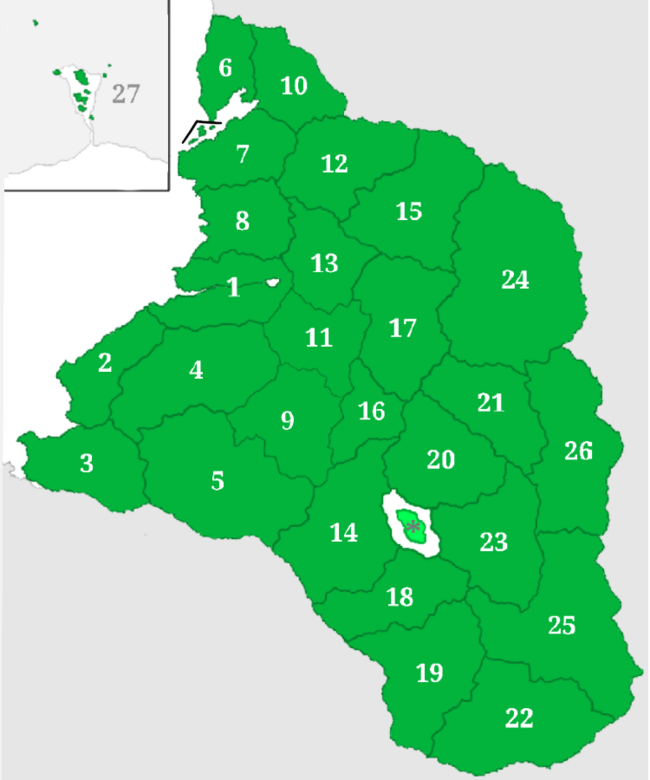
|
| 2 | Luriah | |
| 3 | Pyrisia | |
| 4 | Qaylasiah | |
| 5 | Atredia | |
| 6 | Chondia | |
| 7 | Charonthia | |
| 8 | Androvia | |
| 9 | Ketheria | |
| 10 | Iverniah | |
| 11 | Kharpovia | |
| 12 | Venatoria | |
| 13 | Profania | |
| 14 | Koritia | |
| 15 | Bellatoria | |
| 16 | Cassiopia | |
| 17 | Corkovia | |
| 18 | Aldoria | |
| 19 | Teutoria | |
| 20 | Garganthia | |
| 21 | Kalkhovia | |
| 22 | Carcassonia | |
| 23 | Sopholenia | |
| 24 | Karkarovia | |
| 25 | Kenveciah | |
| 26 | Akrocanthia | |
| 27 | Recondia | |
| * | Axiomia | |

